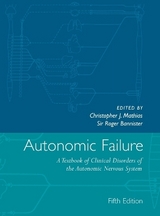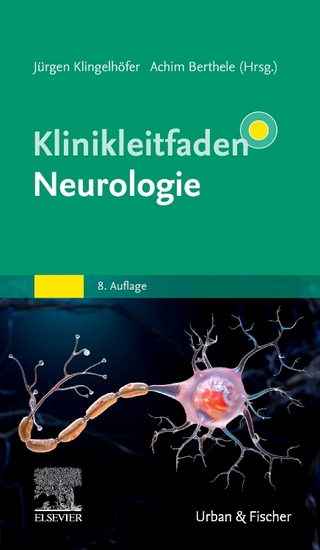
Autonomic Failure
Oxford University Press (Verlag)
978-0-19-262850-3 (ISBN)
- Titel erscheint in neuer Auflage
- Artikel merken
This fourth edition of Autonomic Failure covers the many recent advances made in our understanding of the autonomic nervous system. There are 20 new chapters and extensive revisions of all other contributions. This book makes diagnosis increasingly precise by fully evaluating the underlying anatomical and functional deficits, thereby allowing more effective treatment. This new edition continues to provide practitioners from a variety of fields, including neurology, cardiology, geriatric medicine, diabetology and internal medicine, with a rational guide to aid in the recognition and management of autonomic disorders. The new edition starts with an updated classification of autonomic disorders and a history of the autonomic nervous system. The first two sections of the book deal with the fundamental aspects of autonomic structure, function and integration. There are new chapters dealing with neurobiology, nerve growth factors, genetic mutations, neural and hormonal control of the cerebral circulation, innervation of the lung and pathophysiological mechanisms causing nausea and vomiting.
Advances in the clinical management of autonomic disorders are critically dependent on the bridge between the basic and applied sciences. The third section of the book examines the many technological advances allowing non-invasive investigation of the autonomic nervous system. Section four examines the primary autonomic failure syndromes, in particular multiple system atrophy, the most common neurodegenerative disorder affecting the autonomic nervous system. Section five looks at the major peripheral neuropathies, such as diabetes mellitus and includes new chapters on familial dysautonomia and amyloidosis. The sixth and final section has undergone major expansion as there are now many other disorders known to have considerable autonomic components New chapters are included on neurocardiology, neurally mediated syncope, cardiac and rhythm causes of syncope, shock, migraine, disorders affecting cutaneous blood flow, the effects of drugs, chemicals and toxins, and ageing.
Introduction and classification of autonomic disorders; Historical Perspectives on the autonomic nervous system; PART I - SCIENTIFIC ASPECTS OF STRUCTURE AND FUNCTION; 1. Neurobiology of the autonomic nervous system; 2. Autonomic nervous system development; 3. Nerve growth factors and the autonomic nervous system; 4. Molecular genetic approaches to the autonomic nervous system; 5. Central neurotransmitters & neuromodulators in cardiovascular regulation; 6. Central nervous control of the cardiovascular system; 7. Adrenergic and cholinergic receptors; 8. Structural and chemical organization of the autonomicnervous system with special reference to non-adrenergic, non-cholinergic transmission; 9. Control of blood pressure and the circulation in man; 10. Autonomic and neurohumoral control of the cerebral circulation; PART II - PHYSIOLOGY AND PATHOPHYSIOLOGY RELEVANT TO AUTONOMIC FAILURE; 11. Autoregulation and autonomic control of the cerebral circulation: implications and pathophysiology; 12. Temperature regulation and the autonomic nervous system; 13. Pain and the sympathetic nervous system: pathophysiological mechanisms; 14. Autonomic control of the airways; 15. The gut and the autonomic nervous system; 16. Nausea, vomiting and the autonomic nervous system; 17. The influence of the autonomic nervous system on metabolic function; 18. The kidney and the sympathetic nervous system; 19. Neural control of the urinary bladder and sexual organs; PART III - CLINICAL AUTONOMIC TESTING; 20. Investigation of autonomic disorders; 21. Measurement of heart rate and blood pressure to evaluate dosturbances in neurocardiovascular control; 22. Computer analysis of blood pressure and heart rate variability in subjects with normal and abnormal autonomic cardiovascular control; 23. Intraneural recordings of normal and abnormal sympathetic activity in humans; 24. Neuropharmacological investigation of autonomic failure; 25. Pupil function: tests and disorders; 26. The assessment of sleep disturbances in autonomic failure; 27. Evaluation of sudomotor function; 28. Autonomic function and dysfunction in the gastrointestinal tract; 29. Postprandial hypotension in autonomic disorders; 30. Investigation and treatment of bladder and sexual dusfunction in diseases affecting the autonomic nervous system; PART IV - PRIMARY AUTONOMIC FAILURE: CLINICAL AND PATHOLOGICAL STUDIES IN PURE AUTONOMIC FAILURE AND MULTIPLE SYSTEM ATROPHY; 31. Clinical features and evaluation of the primary chronic autonomic failure syndromes; 32. Neuroimaging and allied studies in autonomic failure syndromes; 33. The neuropathology and neurochemistry of multiple system atrophy; 34. Autonomic ganglia and preganglionic neurones in autonomic failure; 35. Histological studies of skeletal and smooth muscle in autonomic failure; 36. Management of of postural hypotension; 37. The treatment of the motor disorders of multiple system atrophy; PART V - PERIPHERAL AUTONOMIC NEUROPATHIES; 38. Autonomic dysfunction in peripheral nerve disease; 39. Diabetic autonomic failure; 40. Dopamine beta-hydroxylase deficiency - with a note on other genetically determined causes of autonomic failure; 41. Familial dysautonomia; 42. Amyloid neuropathy; PART VI - OTHER DISORDERS ASSOCIATED WITH AUTONOMIC DYSFUNCTION; 43. Introduction of neurocardiology; 44. Syncope and fainting: classification and pathophysiological basis; 45. Neurally mediated syncope; 46. Cardiac causes of syncope; 47. Shock and its management; 48. Sympathetic neural mechanisms in hypertension; 49. Cardiac failure and the autonomic nervous system; 50. Autonomic disorders affecting cutaneous blood flow; 51. Autonomic disturbances in spinal cord lesions; 52. Aautonomic and cerebrovascular aspects of migraine: pathophysiology and treatment; 53. Pain and the sympathetic nervous system; 54. Drugs, chemicals, and toxins that alter autonomic function; 55. Ageing and the autonomic nervous system
| Erscheint lt. Verlag | 1.3.2002 |
|---|---|
| Co-Autor | Sir Roger Bannister |
| Zusatzinfo | numerous halftones and figures |
| Verlagsort | Oxford |
| Sprache | englisch |
| Themenwelt | Medizin / Pharmazie ► Medizinische Fachgebiete ► Neurologie |
| Naturwissenschaften ► Biologie ► Humanbiologie | |
| Naturwissenschaften ► Biologie ► Zoologie | |
| ISBN-10 | 0-19-262850-X / 019262850X |
| ISBN-13 | 978-0-19-262850-3 / 9780192628503 |
| Zustand | Neuware |
| Haben Sie eine Frage zum Produkt? |
aus dem Bereich



